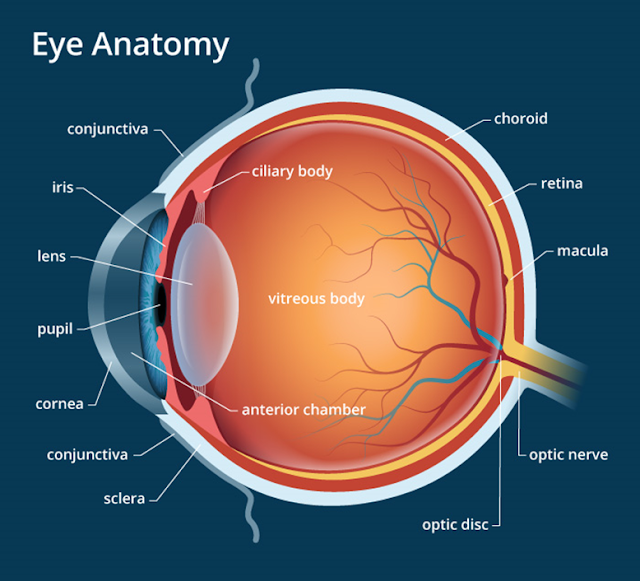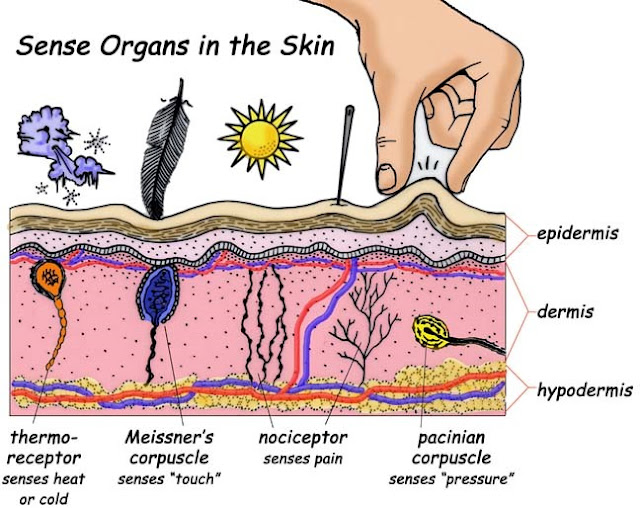Sight is probably the most developed sense in humans, followed closely by hearing. The eye is the organ of vision. It has a complex structure consisting of a transparent lens that focuses light on the retina. The retina is covered with two basic types of light-sensitive cells-rods and cones. The cone cells are sensitive to colour and are located in the part of the retina called the fovea, where the light is focused by the lens. The rod cells are not sensitive to colour, but have greater sensitivity to light than the cone cells. These cells are located around the fovea and are responsible for peripheral vision and night vision. The eye is connected to the brain through the optic nerve. The point of this connection is called the “blind spot” because it is insensitive to light. Experiments have shown that the back of the brain maps the visual input from the eyes.
The brain combines the input of our two eyes into a single three-dimensional image. In addition, even though the image on the retina is upside-down because of the focusing action of the lens, the brain compensates and provides the right-side-up perception. Experiments have been done with subjects fitted with prisms that invert the images. The subjects go through an initial period of great confusion, but subsequently they perceive the images as right side up.
Eye structure
In a number of ways, the human eye works much like a digital camera:
1. Light is focused primarily by the cornea, i.e. the clear front surface of the eye, which acts like a camera lens.
2. The iris of the eye functions like the diaphragm of a camera, controlling the amount of light reaching the back of the eye by automatically adjusting the size of the pupil (aperture).
3. The eye’s crystalline lens is located directly behind the pupil and further focuses light. Through a process called accommodation, this lens helps the eye automatically focus on near and approaching objects, like an autofocus camera lens.
4. Light focused by the cornea and crystalline lens (and limited by the iris and pupil) then reaches the retina i.e. the light-sensitive inner lining of the back of the eye. The retina acts like an electronic image sensor of a digital camera, converting optical images into electronic signals. The optic nerve then transmits these signals to the visual cortex, i.e. the part of the brain that controls our sense of sight.
 |
| Human eye structure, organ of sight |
• Sclera: The knowledge of eye parts and functions is both useful and interesting. The white part of our eyes is known as sclera. It consists of fibrous tissues. The job of this part it to protect the internal parts of the eye.
• Cornea: The transparent tissue through which light enters the eyes is called cornea. It exists in front of the eye. That is why, it looks prominent among different parts of the human eye.
• Iris: Iris is made up of muscles which contract or relax in order to adjust the amount of light which enters the eye.
• Pupil: There are many interesting facts about the pupil. It is, actually, an aperture controlled by the iris muscles. For instance, when it is dark, the iris muscles relax, causing the pupil to open up wider. Therefore, more light enters the eyes to enable us to see better. On the other hand, the pupil becomes narrow due to the contraction of the iris muscles. It occurs in the presence of excessive light in order to protect the cells of the eyes.
• Lens: The lens is present behind the pupil. Light enters the pupil, passes through the lens and is focused on the retina of the eye. The lens is capable of changing its shape in order to help us see near or far off objects. This is about how the human eye works.
• Retina: Digging further deeper into the human eye anatomy, you will come across the retina. The retina converts light into electrical signals which are transferred to the brain for processing. The retina contains two types of cells: rods and cones. These cells are sensitive to light. Rods are important for night-time vision when there is little light. On the other hand, cones play an important role in helping us see colours.
• Optic Nerve: The optic nerve takes electrical signals from the retina of the eye to the brain.
Eye Function
Eye function renders you the sense of sight. They convert light into electrical signals. Afterwards, the brain deciphers these electrical signals into images. Properly working healthy eyes are able to perform the following functions.
· It is one of the important human eye facts that they help us view our surroundings.
· Our eyes enable us to see colours. Certain organisms, such as dogs, cannot see colours and, so, their world is black and white.
· Eyes help us see near as well as distant objects.
Eye Problems
Colour blindness or “Daltonism” is a common abnormality in human vision that makes it impossible to differentiate colours accurately. One type of colour blindness results in the inability to distinguish red from green. This can be a real handicap for certain types of occupations. To a colour-blind person, a person with normal colour vision would appear to have extrasensory perception. However, we want to reserve the term “extrasensory perception” for perception that is beyond the range of the normal.
These extremely delicate organs can fall prey to different eye problems due to allergic factors, unhygienic conditions and the old age. Below are some of the most common diseases of eyes.
Conjunctivitis
Conjunctivitis has got a common name – the pink eye disease. It is an inflammation of conjunctiva, the transparent membrane which covers the sclera. Inflammation of tiny blood vessels found in conjunctiva makes our eyes appear red.
Cataracts
 |
| Cataracts in Human eyes |
Cataracts affect the eye lenses. They may occur due to old age or exist as a defect by birth. Parts of lenses become opaque, blocking the passage of light to the retina, thereby obstructing our vision.
Glaucoma
Glaucoma is a disease which leads to blindness due to a damage to the optic nerve. When the optic nerve fails to transmit electric signals to the brain, an individual is unable to see at all.









